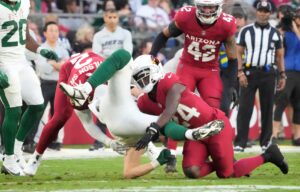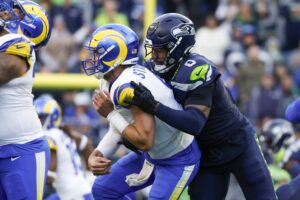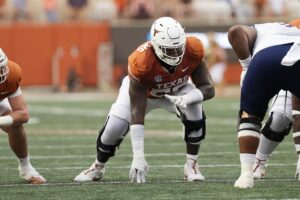The Baltimore Ravens and general manager Eric DeCosta do their best work on NFL draft weekend, and now it’s time to review the results. Since being established as an organization in 1996, the franchise has always been a team that has prioritized the draft. DeCosta and former general manager Ozzie Newsome have always believed that drafting and developing in-house talent is the most important part of developing a consistent contender in the NFL.
2021 was another successful draft but one that is unconventional for the Ravens. Head coach John Harbaugh and the rest of the Ravens coaching staff have been one of the best groups at developing the talent they draft but DeCosta and Newsome have traditionally drafted players with larger histories of college production. Newsome always preached that college production translated to the NFL level but the Ravens drafted a number of players that are a lot more traits than polish in 2021.
While 2021’s group of draftees was another successful effort, most of them are going to take a lot more refining at the next level. The Ravens draft class of 2020 had eight players play in 10 or more games last season and that likely won’t happen with the crop of players picked last weekend. However, this is not a bad thing, but rather is just different than the norm in Baltimore. DeCosta’s rookie class this year has a boatload of upside and should be one of the strongest in the NFL in the coming seasons.
This is a review of the Baltimore Ravens draft in 2021.
- First-round, 27th overall: Rashod Bateman (Minnesota) – Wide Receiver
- First-round 31st overall: Jayson Oweh (Penn State) – EDGE
- Third-round 94th overall: Ben Cleveland (Georgia) – Guard
- Third-round 105th overall: Brandon Stephens (SMU) – Defensive Back
- Fourth-round 131st overall: Tylan Wallace (Oklahoma State) – Wide Receiver
- Fifth-round 160th overall: Shaun Wade (Ohio State) – Cornerback
- Fifth-round 171st overall: Daelin Hayes (Notre Dame) – Defensive End
- Fifth-round 184th-overall: Ben Mason (Michigan) – Fullback/Tight end
Baltimore Ravens 2021 NFL Draft Grade: 7.9/10
Baltimore Ravens 2021 NFL Draft Review
The Best Pick: Rashod Bateman (Minnesota) – Wide Receiver
The Ravens have made it known they want to improve at the receiver position. Prior to the draft, Sammy Watkins signing a one-year(s)/$6 million contract was the only significant addition Baltimore had made in the passing game this off-season. DeCosta had offered contracts to free agents T.Y. Hilton and Juju Smith-Schuster but both receivers opted to stay with their teams from 2020. They have also inquired about trading for Julio Jones, according to Jay Glazer. While a trade for Jones could still happen, the Ravens are clearly still looking for a difference-maker at the wide receiver to help Lamar Jackson elevate his passing game.
Lamar Jackson is getting another WR in Baltimore 😤
The Ravens select Minnesota's Rashod Bateman with the No. 27 pick. #NFLDraft pic.twitter.com/WM74YmdsWL
— SportsCenter (@SportsCenter) April 30, 2021
Bateman is about as ideal a pick as DeCosta and Harbaugh could’ve hoped for. He is not the sexiest receiver in the draft but he has an incredibly high floor and a skill set that complements what the Ravens already have in-house. His hands are incredibly safe, he plays much bigger than his 6’3/8″ 190 lbs frame, has great release at the line of scrimmage, and is sneaky quick (4.39u). Bateman was also asked to do a lot of run blocking due to the Golden Gophers switching to a more run-heavy attack in 2020. DeCosta and Harbaugh could not have had a better player than Bateman fit both their need at wide receiver and value at 27th-overall.
[pickup_prop id=”6803″]
The Suprise: Jayson Oweh (Penn State) – EDGE
Baltimore’s pass rush has easily been their weakest defensive unit over the past three years. While Don Martindale’s blitz-heavy scheme has produced the most players with a sack over that time period, finding an EDGE that can consistently win 1-on-1 on the outside has been an incredibly elusive task. Matt Judon led the Ravens in sacks in 2020 but registered a meager 6.0 in 14 games. Terrell Suggs was the last Ravens player to record double-digit sacks with 11.0 back in 2017.
Oweh is debatably the rawest player that was selected in the first round this year. Saying he is athletic is an understatement as the pass rusher ran a 4.36u at 6’5″ 257 lbs with a crazy 11’2″ broad jump and a 39.5′ vertical jump. However, per Pro Football Focus, he had just 10 pressures all of 2020 outside of his first game against Indiana (where he had 10 pressures on the day). Oweh’s lack of production is partly due to inexperience as well. He did not start playing football until his junior year of high school and needs to develop a real set of pass rush moves before he turns into a starting-caliber EDGE in the NFL.
After watching Odafe Oweh's pro day, Ravens OLB coach Drew Wilkins told DC Don "Wink" Martindale:
It was the best workout he's ever seen live.
— Jamison Hensley (@jamisonhensley) April 30, 2021
Selecting Oweh is not a surprise because of the value or the position he will fill but rather because it went completely against the mold the Ravens typically look for in their EDGE defenders. Newsome was a big preacher of college production translating directly to the NFL and Oweh did not have a sack in 2020. Oweh has boom-or-bust written all over him but Martindale will give the physical freak a chance to rack up sacks in a defense that historically develops highly successful pass rushers.
The Head-Scratcher: Brandon Stephens (SMU) – Defensive Back
Stephens comes to Baltimore with as much mystery as Oweh. Originally recruited as a running back at UCLA, he transferred to SMU before making the switch to cornerback. Here, Stephens did something quite impressive as a junior; he started 23 straight games over two seasons having only played the position briefly in high school. Over those 23 games, he registered 92 total tackles, 22 pass defenses, and one interception — leading the AAC in pass defenses with 10 this past season.
Stephens is not only a project but a BIG project. Before arriving at SMU, Stephens had never even picked up a defensive playbook. He will now get the opportunity to sit and study behind Marlon Humphrey, Marcus Peters, and one of the best secondaries in the NFL. There is a good chance that Stephens does not even have a set position entering training camp but his ability to succeed after making the switch from running back to defensive back could be a sign that his best football is in front of him. Stephens acknowledged a willingness to play anywhere in the secondary saying “I pride myself in playing multiple positions…where ever the team needs me to play, I’ll play” when asked about what position will play for the Ravens.
Drafting another raw talent like Stephens is an interesting move by DeCosta but one that is likely made with the mindset of a long-term contender. Baltimore’s secondary has All-Pro-level talent at almost every position and Stephens may not even make the 53-man roster. However, it is impossible to be too deep at defensive back and DeCosta drafted a player that the Ravens can shape by themselves.
The Steal: Tylan Wallace (Oklahoma State) – Wide Receiver
For the fourth straight year, the Ravens picked multiple receivers in the draft. After selecting Bateman in the first round, DeCosta opted for great value over need when taking the aggressive and explosive Wallace. He’s a big-play threat that plays much bigger than his size and comes with a long history of production at Oklahoma State. Wallace gained regular playing time as a sophomore in college and recorded 14 100+ yard games in his final three seasons at Oklahoma State while averaging over 15.5 yards per catch.
Wallace, like Bateman, plays far bigger than his frame. At 5’11” 194 lbs, he was a monster at the catch point, making the most contested catches in the nation since 2018 per PFF.
Tylan Wallace since 2018:
💥15+ yard REC – 73 (2nd)
💪Contested catches – 43 (1st)#NFLDraft sleeper for the Ravens?
pic.twitter.com/eBrMqtOhft— PFF (@PFF) May 1, 2021
The question now becomes, where does Wallace fit into the Ravens offense? Wallace was primarily used on the outside in college but his profile fits one of a slot receiver. Devin Duvernay is projected to fill the slot role Willie Snead vacated this off-season but Wallace could gain reps as a rookie at the position as well. Neither he nor Duvernay is proven in the NFL and both bring very athletic profiles to a very dynamic offense. If offensive coordinator Greg Roman wants to get the most out of Wallace, he will give him reps out of multiple alignments and different play types. He could be a huge asset to the Ravens as a rookie but even more so when they find out of to properly deploy him as a pro.
Most likely to turn heads during training camp: Jayson Oweh
There will be no player in camp that turns heads like Oweh this coming season. His 4.37 40-time and 11’2″ broad jump were both the highest numbers ever recorded for a defensive end prospect. The Ravens have historically looked for high sack totals at the college level when evaluating their EDGE rushers but Oweh is a different breed. The athletic tools he possesses cannot be taught and should have him racking up sacks against NFL competition in no time.
#PennState EDGE Jayson Oweh (reported numbers):
• HT/WT: 6’5, 252, rSO
• 40: 4.33
• Vert: 36”
• Broad: 10’7”Former basketball player that was convinced to play football in HS. Finished his season debut with 4 QB pressures.
(🎥@BenFennell_NFL)pic.twitter.com/7mZ8S8jdPo
— Jordan Reid (@Jordan_Reid) October 26, 2020
While Oweh put up very underwhelming stats at Penn State, he is going to have far more opportunities to get to the quarterback with the Ravens. Baltimore led the NFL in blitz percentage for the third year in a row in 2020 and Martindale’s scheme allows for ample opportunities to not only rush the quarterback but get unblocked looks. Martindale will likely try to turn Oweh loose in as many situations as possible by utilizing his supreme athleticism.
The Rest
Prior to Orlando Brown Jr. being traded to the Kansas City Chiefs, bolstering Baltimore’s interior offensive line was a higher priority than the outside for DeCosta. Weak pass protection on the interior has been the Ravens undoing in each of their past four playoff games and Ben Cleveland is just another shot at finding stability on the interior. He is a mountain of a man at 6’6″ 343 lbs and wants to bully players when he’s out on the field. His play strength and power will not be a concern in the NFL but he needs to improve his processing before getting a chance to start. Cleveland may not be ready to assume the Ravens left guard position to start 2021 but he has a chance to win that role later down the line
Shaun Wade has been one of the biggest fallers since the beginning of the college football season in 2020. His 2019 season finished with him getting ejected from the National Championship Semi-Final game for a questionable targeting call against Clemson’s Trevor Lawrence and his 2020 didn’t go much better. He had a lot of success manning the slot for Ohio State between Jeffrey Okudah and Damon Arnette in 2019 but struggled last season when asked to make the move outside. Despite this, the Ravens could use Wade in a role similar to that of Tavon Young. Young has missed three of the past four seasons and the Ravens need a backup plan in case he gets hurt again in 2021. Wade is a low-risk/high-reward pick in the fifth round.
Daelin Hayes is another project EDGE like Oweh. He was raw before coming to Notre Dame and has an injury history that limited his chances to play full seasons in college. However, he has been touted as a vocal leader and has reliable athleticism for a 6’3″ EDGE. Hayes’ put a number of good reps on tape at the Senior Bowl and could become a better pro than college player if he is able to better utilize his hand movements and quickness off of the snap.
Ben Mason is another fullback in the vein as Patrick Ricard. He played as both a defensive tackle and full back at Michigan and could be Ricard’s successor as his contract is set to expire following the 2021 season. There are questions about Mason’s ability as a pass-catcher but he was named Michigan’s toughest player in two separate seasons and has a history of production on the goal line. He managed to find the end zone seven times in 2018. His run blocking at the point of attack is stout, he just needs to develop his effectiveness as a fullback on passing downs.
Main photo:
Embed from Getty Images






